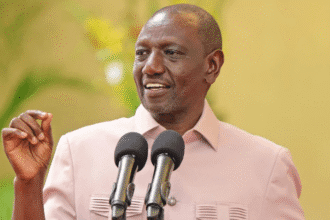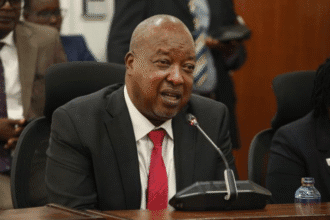Raila Odinga, the opposition chief and leader of the Azimio la Umoja coalition, is grappling with an escalating fallout among his key allies, posing a significant challenge to the coalition’s unity and its role as Kenya’s main opposition force. Recent developments have laid bare the internal discord within Azimio, raising questions about the coalition’s future as a cohesive political entity. As tensions rise and public disagreements among senior figures continue to unfold, the fallout threatens to derail the opposition’s agenda at a crucial time in Kenyan politics.
Cracks Emerge in the Azimio Coalition
Azimio la Umoja, which brought together a broad alliance of political parties and figures in the run-up to the 2022 elections, has seen its once-strong unity increasingly strained. Initially formed to present a united front against President William Ruto’s Kenya Kwanza coalition, Azimio now appears to be struggling to maintain internal coherence, with disagreements spilling over into the public domain

At the core of the fallout are leadership disputes and strategic differences, with some allies accusing Odinga of sidelining coalition partners in key decision-making processes. Kalonzo Musyoka, leader of the Wiper Democratic Movement and a prominent figure in Azimio, has been outspoken in his criticism of Odinga’s leadership style. Musyoka has raised concerns about a lack of consultation on major issues, including the coalition’s stance on anti-government protests and electoral reforms.
Musyoka’s dissatisfaction echoes a broader sentiment among some Azimio leaders who feel marginalized in the coalition’s strategic decisions. The friction highlights the challenges of maintaining a united opposition front, as divergent interests and leadership styles clash within the alliance.

Musyoka has pointed out that strategic decisions, including the call for anti-government protests, were made without comprehensive consultation. This lack of inclusivity, according to Musyoka, undermines the coalition’s effectiveness and unity, making it increasingly difficult to maintain a cohesive opposition front.
Diverging Interests and Political Ambitions
The fallout within Azimio is not merely about leadership; it is also fueled by diverging political interests and ambitions among the coalition’s key players. As the political landscape shifts, some Azimio members are exploring alternative alignments, either within the coalition or with external political forces. This realignment reflects the growing sense of unease among leaders who feel that their regional or personal political goals are not adequately represented within Azimio’s current strategy.
Martha Karua, Odinga’s former running mate in the 2022 elections, has been a vocal critic of the coalition’s approach, calling for a more democratic and consultative process within Azimio. Karua’s stance has resonated with those who believe that a more inclusive leadership style could help bridge the growing divides within the alliance. Her calls for reform underscore the tensions between maintaining a collective opposition identity and catering to the individual aspirations of coalition members.
Strategic Disagreements Over Electoral Reforms
Electoral reforms have been a central pillar of Azimio’s platform, with Odinga consistently advocating for changes to Kenya’s electoral system to ensure fairer elections. However, the coalition is divided on how best to pursue these reforms. Odinga’s confrontational approach, which includes organizing mass protests and challenging the legitimacy of Ruto’s administration, has not found universal support within Azimio.
Kalonzo Musyoka and other moderate voices within the coalition argue for a more measured approach, emphasizing dialogue and negotiation over street demonstrations. This strategic disagreement has become a flashpoint within Azimio, with some members fearing that an overly aggressive stance could backfire, alienating potential supporters and undermining the coalition’s credibility.
The public disagreements over strategy have highlighted the difficulties Azimio faces in crafting a unified approach to opposition politics. As coalition leaders continue to debate the best path forward, the lack of consensus threatens to weaken Azimio’s ability to present a coherent challenge to the ruling administration.
ODM on the defensive
Meanwhile, as tensions grow within Azimio, ODM has defended its decision to join Ruto’s cabinet, stating that it has not signed any coalition agreement with the ruling United Democratic Alliance (UDA) to form a unity government. The party clarified that it only allowed Ruto to use its experts in their individual capacities to serve the nation after the deadly anti-government protests that began in June 2024.
In his defence Raila Odinga stressed that his party is still in the opposition of the country and he remains a strong member of the Azimio la Umoja One Kenya coalition, insisting that the responsibility on making sure that Ruto’s government is on toes has not changed.
He cited that the Azimio La Umoja Coalition will work in accordance with the ethics of our party ODM and the Azimio coalition
Implications for Kenya’s Political Landscape
The fallout within Azimio la Umoja comes at a critical time for Kenya’s political opposition. As the country looks ahead to future elections, the opposition’s ability to maintain a united front will be essential for mounting an effective challenge to the ruling coalition. The current disunity within Azimio not only undermines its credibility but also raises broader questions about the feasibility of coalition politics in Kenya’s complex political environment.
For Raila Odinga, the fallout represents a significant challenge to his leadership and legacy. How he navigates the internal discord within Azimio will likely shape the coalition’s future and his role within it. As tensions continue to simmer, the stakes are high for Kenya’s opposition, which faces the daunting task of reasserting its relevance and coherence in a rapidly evolving political landscape.
Conclusion
Raila Odinga’s fallout with key allies in Azimio la Umoja underscores the challenges of coalition politics in Kenya. As disagreements over leadership, strategy, and political direction continue to surface, the coalition that once promised to reshape Kenya’s political landscape now appears increasingly divided. Whether Azimio can overcome its internal strife and rebuild its unity remains an open question. For now, the fallout serves as a stark reminder of the complexities inherent in opposition politics, where alliances are often as fragile as they are necessary.




